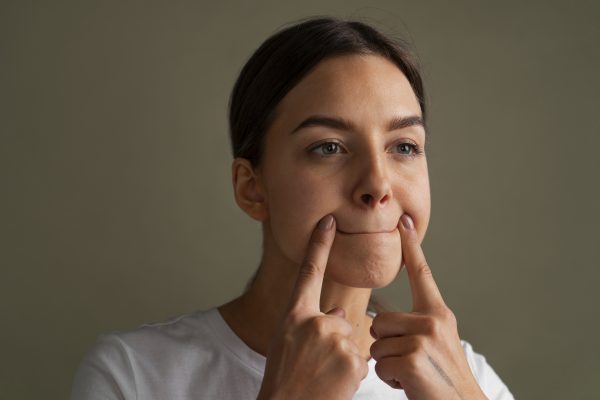
Smile lines, also known as nasolabial folds, are the creases that form around the mouth and extend towards the nose. While they’re a natural part of ageing, many people seek ways to reduce their appearance for a more youthful look. In this article, we’ll delve into the causes of smile lines, explore treatment options, and discuss how to reduce the appearance of smile lines to maintain smooth, youthful skin.
What Causes Smile Lines?

Smile lines develop as a result of various factors, including:
Ageing:
As we age, the skin loses its elasticity and firmness due to a decrease in collagen and elastin production. This leads to the formation of wrinkles and fine lines, including smile lines.
Sun Exposure:
Prolonged exposure to the sun’s harmful UV rays accelerates skin ageing and contributes to the breakdown of collagen and elastin fibres, leading to the formation of wrinkles and smile lines.
Facial Expressions:
Repeated facial movements, such as smiling, laughing, and squinting, can contribute to the development of smile lines over time.
Genetics:
Genetic predisposition plays a role in determining the formation and severity of smile lines. Some individuals may be more prone to developing prominent nasolabial folds due to their genetic makeup.
How to Get Rid of Smile Lines?
While smile lines are a natural part of ageing, several treatments for smile lines can help minimise their appearance:
Dermal Fillers:
Hyaluronic acid-based dermal fillers, such as Juvederm and Restylane, can be injected into the smile lines to add volume and plump up the skin, reducing the appearance of wrinkles.
Botox:
Botulinum toxin injections, commonly known as Botox, can relax the muscles around the mouth, preventing them from contracting and causing the formation of smile lines.
Profhilo:
Profhilo is a bio-remodeling injectable treatment that stimulates collagen and elastin production, improving skin hydration and elasticity, and reducing the appearance of smile lines.
How to Prevent Smile Lines?
While it’s not possible to completely prevent smile lines, you can take steps to minimise their development:
Protect Your Skin from the Sun:
Wear sunscreen with a high SPF daily, seek shade, and wear protective clothing to shield your skin from the sun’s harmful UV rays, reaping the benefits of sunscreen for skin protection.
Maintain a Healthy Lifestyle:
Eat a balanced diet rich in fruits, vegetables, and antioxidants, stay hydrated, exercise regularly, and avoid smoking and excessive alcohol consumption, which can accelerate skin ageing.
Practice Good Skincare:
Establish a skincare routine that includes cleansing, moisturising, and using anti-ageing products with ingredients like retinol and vitamin C to promote collagen production and improve uneven skin texture.
Takeaway
Smile lines are a common sign of ageing, but they can be minimised with various treatment options and preventive measures. Consult a professional at Bodycraft Clinic to help you understand which treatment would be suitable to address nasolabial folds on your skin and boost your confidence. Remember, embracing your smile lines is a celebration of a life filled with laughter and joy.
FAQs around Smile Lines
1. Are smile lines attractive?
Beauty is subjective, and opinions on smile lines vary from person to person. Some may find smile lines endearing, associating them with a life filled with laughter and joy. Others may prefer a smoother, more youthful appearance. Ultimately, whether smile lines are considered attractive depends on individual preferences and cultural norms.
2. How do you remove smile lines naturally?
While there’s no guaranteed way to remove smile lines naturally, certain lifestyle habits and skincare practices may help minimise their appearance:
-
- Stay hydrated to maintain skin elasticity.
-
- Eat a balanced diet rich in fruits and vegetables for essential nutrients.
-
- Use moisturisers and serums containing ingredients like hyaluronic acid, retinol, and vitamin C to hydrate the skin and promote collagen production.
-
- Practice facial exercises to strengthen facial muscles and improve skin tone.
-
- Protect your skin from sun damage by wearing sunscreen daily and avoiding prolonged sun exposure.
3. Why are my smile lines dark?
The darkening of smile lines may be attributed to several factors, including:
-
- Hyperpigmentation: Excessive melanin production in the skin can cause the darkening of smile lines.
-
- Sun Exposure: UV radiation from the sun can stimulate melanin production, leading to darkening of the skin.
-
- Poor Skincare: Neglecting to cleanse and moisturise the skin properly can contribute to the accumulation of dead skin cells and debris, resulting in darker smile lines.
4. Why do smile lines appear?
Smile lines, also known as nasolabial folds, appear primarily due to the natural ageing process and a loss of skin elasticity. Factors such as sun exposure, genetics, and repeated facial expressions also contribute to the formation of smile lines over time. As collagen and elastin production decline with age, the skin becomes less firm and resilient, leading to the development of wrinkles and creases, including smile lines.
5. How much does filler cost for smile lines?
The cost of filler for smile lines varies depending on factors such as the type of filler used, the amount needed, and the practitioner’s expertise. On average, the cost of dermal fillers for smile lines can range from a few hundred to over a thousand dollars per syringe. It’s essential to consult with a qualified healthcare professional to determine the most suitable treatment plan and obtain an accurate cost estimate based on your individual needs and goals.